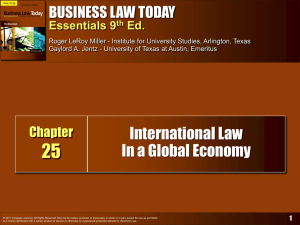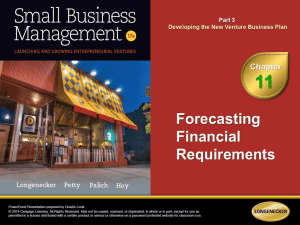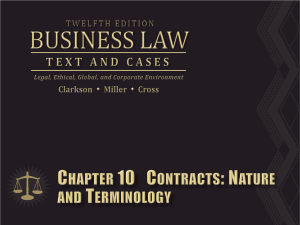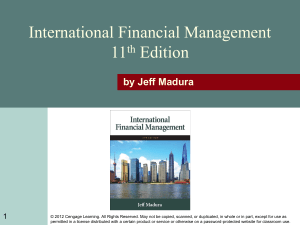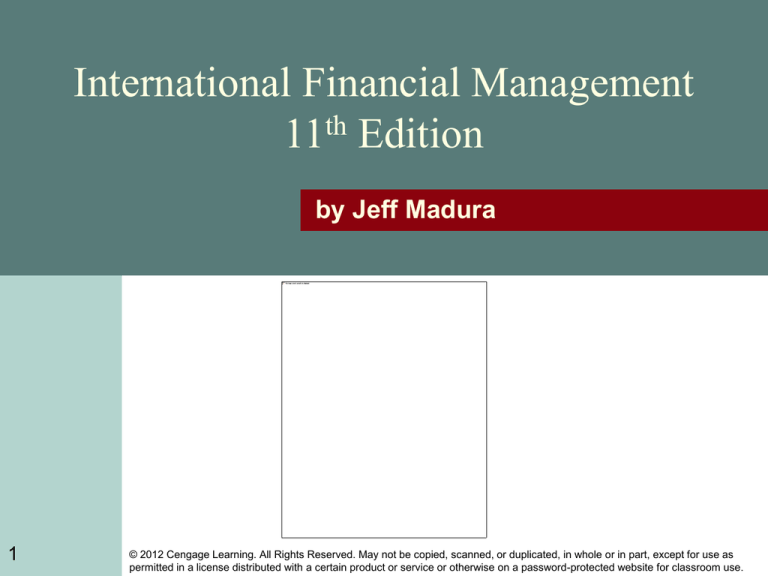
International Financial Management
11th Edition
by Jeff Madura
1
© 2012 Cengage Learning. All Rights Reserved. May not be copied, scanned, or duplicated, in whole or in part, except for use as
permitted in a license distributed with a certain product or service or otherwise on a password-protected website for classroom use.
Part 3 Exchange Rate Risk Management
2
© 2012 Cengage Learning. All Rights Reserved. May not be copied, scanned, or duplicated, in whole or in part, except for use as
permitted in a license distributed with a certain product or service or otherwise on a password-protected website for classroom use.
9 Forecasting Exchange Rates
Chapter Objectives
Explain how firms can benefit from forecasting
exchange rates
Describe the common techniques used for
forecasting
Explain how forecasting performance can be
evaluated
explain how interval forecasts can be applied
3
© 2012 Cengage Learning. All Rights Reserved. May not be copied, scanned, or duplicated, in whole or in part, except for use as
permitted in a license distributed with a certain product or service or otherwise on a password-protected website for classroom use.
Why Firms Forecast Exchange Rates
1. Hedging decisions
Whether a firm hedges may be determined by its forecasts of
foreign currency values.
2. Short-term investment decisions
Corporations sometimes have a substantial amount of excess cash
available for a short time period. Large deposits can be established
in several currencies.
3. Capital budgeting decisions
When an MNC’s parent assesses whether to invest funds in a
foreign project, the firm takes into account that the project may
periodically require the exchange of currencies.
4
© 2012 Cengage Learning. All Rights Reserved. May not be copied, scanned, or duplicated, in whole or in part, except for use as
permitted in a license distributed with a certain product or service or otherwise on a password-protected website for classroom use.
Why Firms Forecast Exchange Rates (Cont.)
4. Earnings assessment
The parent’s decision about whether a foreign subsidiary should
reinvest earnings in a foreign country or remit earnings back to the
parent may be influenced by exchange rate forecasts.
5. Long-term financing decisions
MNCs that issue bonds to secure long-term funds may consider
denominating the bonds in foreign currencies.
5
© 2012 Cengage Learning. All Rights Reserved. May not be copied, scanned, or duplicated, in whole or in part, except for use as
permitted in a license distributed with a certain product or service or otherwise on a password-protected website for classroom use.
Exhibit 9.1 Corporate Motives for Forecasting
Exchange Rates
6
© 2012 Cengage Learning. All Rights Reserved. May not be copied, scanned, or duplicated, in whole or in part, except for use as
permitted in a license distributed with a certain product or service or otherwise on a password-protected website for classroom use.
Forecasting Techniques
1. Technical Forecasting
2. Fundamental Forecasting
3. Market-Based Forecasting
7
© 2012 Cengage Learning. All Rights Reserved. May not be copied, scanned, or duplicated, in whole or in part, except for use as
permitted in a license distributed with a certain product or service or otherwise on a password-protected website for classroom use.
Technical Forecasting
1. Involves the use of historical exchange rate
data to predict future values
2. Limitations of technical forecasting:
a. Focuses on the near future
b. Rarely provides point estimates or range of
possible future values
c. Technical forecasting model that worked well in
one period may not work well in another
8
© 2012 Cengage Learning. All Rights Reserved. May not be copied, scanned, or duplicated, in whole or in part, except for use as
permitted in a license distributed with a certain product or service or otherwise on a password-protected website for classroom use.
Fundamental Forecasting
1. Based on fundamental relationships between economic
variables and exchange rates
2. Use of sensitivity analysis
Considers more than one possible outcome for the factors
exhibiting uncertainty.
3. Use of PPP
While the inflation differential by itself is not sufficient to
accurately forecast exchange rate movements, it should be
included in any fundamental forecasting model.
4. Limitations of fundamental forecasting include:
a.
b.
c.
d.
9
Unknown timing of the impact of some factors
Forecasts of some factors may be difficult to obtain
Some factors are not easily quantified
Regression coefficients may not remain constant
© 2012 Cengage Learning. All Rights Reserved. May not be copied, scanned, or duplicated, in whole or in part, except for use as
permitted in a license distributed with a certain product or service or otherwise on a password-protected website for classroom use.
Market-Based Forecasting
Use of the spot rate to forecast the future spot rate.
Use of the forward rate to forecast the future spot rate.
E (e) p
S 1
E (e) F
where
E(e) expected
p percentage
percentage
by which t
change in the exchange
he forward
rate
rate (F)
exceeds the spot rate (S)
The forward rate should serve as a reasonable forecast for
the future spot rate because otherwise speculators would
trade forward contracts (or futures contracts) to capitalize
on the difference between the forward rate and the
expected future spot rate.
10
© 2012 Cengage Learning. All Rights Reserved. May not be copied, scanned, or duplicated, in whole or in part, except for use as
permitted in a license distributed with a certain product or service or otherwise on a password-protected website for classroom use.
Market-Based Forecasting (Cont.)
Long-Term Forecasting with Forward Rates
Long-term exchange rate forecasts can be derived from long-term
forward rates. Like any method of forecasting exchange rates, the
forward rate is typically more accurate when forecasting exchange
rates for short-term horizons than for long-term horizons.
Implications of the IFE for Forecasts
Since the forward rate captures the interest rate differential (and
therefore the expected inflation rate differential) between two
countries, it should provide more accurate forecasts for currencies
in high-inflation countries than the spot rate.
11
© 2012 Cengage Learning. All Rights Reserved. May not be copied, scanned, or duplicated, in whole or in part, except for use as
permitted in a license distributed with a certain product or service or otherwise on a password-protected website for classroom use.
Mixed Forecasting
Use a combination of forecasting techniques. (Exhibit
9.2)
Mixed forecast is then a weighted average of the various
forecasts developed.
Guidelines for Implementing a Forecast
All managers of an MNC should rely on the same exchange
rate forecasts.
MNCs may complement their forecast by hiring forecasting
services to obtain exchange rate forecasts.
12
© 2012 Cengage Learning. All Rights Reserved. May not be copied, scanned, or duplicated, in whole or in part, except for use as
permitted in a license distributed with a certain product or service or otherwise on a password-protected website for classroom use.
Exhibit 9.2 Forecasts of the Mexican Peso Drawn from
Each Forecasting Technique
13
© 2012 Cengage Learning. All Rights Reserved. May not be copied, scanned, or duplicated, in whole or in part, except for use as
permitted in a license distributed with a certain product or service or otherwise on a password-protected website for classroom use.
Forecast Error
1. Measurement of forecast error
Absolute forecast error as a percentage of the realized value = (forecasted value
– realized value) / realized value
2. Forecast error among time horizons
The potential forecast error for a particular currency depends on the
forecast horizon.
3. Forecast error over time periods (Exhibit 9.3 next slide)
The forecast error for a given currency changes over time.
4. Forecast errors among currencies (Exhibit 9.4 second slide)
The ability to forecast currency values may vary with the currency of
concern.
5. Forecast bias
When a forecast error is measured as the forecasted value minus the
realized value, negative errors indicate underestimating, while positive
errors indicate overestimating.
14
© 2012 Cengage Learning. All Rights Reserved. May not be copied, scanned, or duplicated, in whole or in part, except for use as
permitted in a license distributed with a certain product or service or otherwise on a password-protected website for classroom use.
Exhibit 9.3 Absolute Forecast Error (as % of Realized
Value) for the British Pound over Time
15
© 2012 Cengage Learning. All Rights Reserved. May not be copied, scanned, or duplicated, in whole or in part, except for use as
permitted in a license distributed with a certain product or service or otherwise on a password-protected website for classroom use.
Exhibit 9.4 How the Forecast Error Is Influenced by
Volatility
16
© 2012 Cengage Learning. All Rights Reserved. May not be copied, scanned, or duplicated, in whole or in part, except for use as
permitted in a license distributed with a certain product or service or otherwise on a password-protected website for classroom use.
Statistical Test of Forecast Bias
1. A conventional method of testing for a forecast bias is
to apply the following regression model to historical
data.
S t a 0 a 1 Ft 1 t
where
S t spot rate at time t
Ft 1 forward
rate at time t - 1
t error term
a 0 intercept
a 1 regression
17
coefficien
t
© 2012 Cengage Learning. All Rights Reserved. May not be copied, scanned, or duplicated, in whole or in part, except for use as
permitted in a license distributed with a certain product or service or otherwise on a password-protected website for classroom use.
Graphic Evaluation of Forecast Bias
1. Forecast bias can be examined with the use of a
graph that compares forecasted values with the
realized values for various time periods. (Exhibits
9.5 & 9.6)
2. Shifts in Forecast Bias over Time
Because the forecast bias can change over time, refining a
forecast to adjust for a forecast bias detected in the past is not
a perfect solution.
18
© 2012 Cengage Learning. All Rights Reserved. May not be copied, scanned, or duplicated, in whole or in part, except for use as
permitted in a license distributed with a certain product or service or otherwise on a password-protected website for classroom use.
Exhibit 9.5 Evaluation of Forecast Performance
19
© 2012 Cengage Learning. All Rights Reserved. May not be copied, scanned, or duplicated, in whole or in part, except for use as
permitted in a license distributed with a certain product or service or otherwise on a password-protected website for classroom use.
Exhibit 9.6 Graphic Evaluation of Forecast Performance
20
© 2012 Cengage Learning. All Rights Reserved. May not be copied, scanned, or duplicated, in whole or in part, except for use as
permitted in a license distributed with a certain product or service or otherwise on a password-protected website for classroom use.
Comparison of Forecasting Methods
An MNC can compare forecasting methods by
plotting the points relating to two methods on a
graph similar to Exhibit 9.6.
The performance of the two methods can be
evaluated by comparing distances of points from the
45-degree line.
In some cases, neither forecasting method may stand
out as superior when compared graphically.
21
© 2012 Cengage Learning. All Rights Reserved. May not be copied, scanned, or duplicated, in whole or in part, except for use as
permitted in a license distributed with a certain product or service or otherwise on a password-protected website for classroom use.
Exhibit 9.7 Comparison of Forecast Techniques
22
© 2012 Cengage Learning. All Rights Reserved. May not be copied, scanned, or duplicated, in whole or in part, except for use as
permitted in a license distributed with a certain product or service or otherwise on a password-protected website for classroom use.
Forecasting under Market Efficiency
1. Weak-form efficiency: historical and current
exchange rate information is already reflected in
today’s exchange rate and is not useful for
forecasting.
2. Semistrong-form efficiency: all relevant public
information is already reflected in today’s exchange
rate.
3. Strong-form efficiency: all relevant public and private
information is already reflected in today’s exchange
rate.
23
© 2012 Cengage Learning. All Rights Reserved. May not be copied, scanned, or duplicated, in whole or in part, except for use as
permitted in a license distributed with a certain product or service or otherwise on a password-protected website for classroom use.
Methods of Forecasting Exchange Rate Volatility
1. Use of recent volatility level
The volatility of historical exchange rate movements over
a recent period can be used to forecast the future.
2. Use of historical pattern of volatilities
If there is a pattern to the changes in exchange rate
volatility over time, a series of time periods may be used
to forecast volatility in the next period.
3. Implied standard deviation
Derive the exchange rate’s implied standard deviation
(ISD) from the currency option pricing model.
24
© 2012 Cengage Learning. All Rights Reserved. May not be copied, scanned, or duplicated, in whole or in part, except for use as
permitted in a license distributed with a certain product or service or otherwise on a password-protected website for classroom use.
SUMMARY
Multinational corporations need exchange rate forecasts to
make decisions on hedging payables and receivables, shortterm financing and investment, capital budgeting, and longterm financing.
The most common forecasting techniques can be classified as
(1) technical, (2) fundamental, (3) market based, and (4)
mixed. Each technique has limitations, and the quality of the
forecasts produced varies. Yet due to the high variability in
exchange rates, each technique has limited accuracy.
25
© 2012 Cengage Learning. All Rights Reserved. May not be copied, scanned, or duplicated, in whole or in part, except for use as
permitted in a license distributed with a certain product or service or otherwise on a password-protected website for classroom use.
SUMMARY (Cont.)
Forecasting methods can be evaluated by comparing the
actual values of currencies to the values predicted by the
forecasting method. To be meaningful, this comparison
should be conducted over several periods. Two criteria used
to evaluate performance of a forecast method are bias and
accuracy. When comparing the accuracy of forecasts for two
currencies, the absolute forecast error should be divided by
the realized value of the currency to control for differences in
the relative values of currencies.
26
© 2012 Cengage Learning. All Rights Reserved. May not be copied, scanned, or duplicated, in whole or in part, except for use as
permitted in a license distributed with a certain product or service or otherwise on a password-protected website for classroom use.



